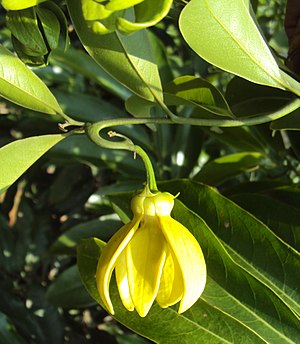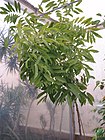Note: This is a project under development. The articles on this wiki are just being initiated and broadly incomplete. You can Help creating new pages.
Artabotrys hexapetalus - Harachampaka
Climbing ylang ylang is an evergreen climbing or scandent shrub growing up to 8 metres tall. A powerful, far-reaching, many-stemmed woody climber, the old stems of great thickness.
Uses
Parts Used
Chemical Composition
Common names
| Language | Common name |
|---|---|
| Kannada | Kandaala sampige, Madana kaamaeshvari, Manoranjana |
| Hindi | Harichampa, Madanmast |
| Malayalam | Madanakameswari, Manoranjitam |
| Tamil | Manoranjitham |
| Telugu | Manoranjithamu, Muddasampenga, Phalasampanga, Manoranjidamu |
| Marathi | Hiravaachaapa, Hirvachampa |
| Gujarathi | |
| Punjabi | |
| Kashmiri | |
| Sanskrit | Harachampaka, Madanah, Nilachampaka |
| English |
Properties
Reference: Dravya - Substance, Rasa - Taste, Guna - Qualities, Veerya - Potency, Vipaka - Post-digesion effect, Karma - Pharmacological activity, Prabhava - Therepeutics.
Dravya
Rasa
Guna
Veerya
Vipaka
Karma
Prabhava
Habit
Identification
Leaf
| Kind | Shape | Feature |
|---|---|---|
| Simple | Elliptic-oblong | Leaves alternate, acute at base, shortly acuminate at apex, 6-15 x 2- 4.5 cm, glabrous; lateral nerves 6-18 pairs. |
Flower
| Type | Size | Color and composition | Stamen | More information |
|---|---|---|---|---|
| Bisexual | solitary | Yellow | Many | Flowers solitary or paired on terminal or leaf opposed hooked peduncles, ca 2 cm across, fragrant; pedicels ca 1 cm long, pubescent. Sepals ovate, recurved, 5-7.5 x 5-6 cm, pubescent. Petals lanceolate, saccate or concave at base; outer ones 2-3 x 0.5-0.7 cm; the inner slightly smaller, appressed-villous. Stamens many, anthers beaked concealing the anther cells. Carpels many, oblong, pubescent or glabrous; ovules 2; stigma clavate |
Fruit
| Type | Size | Mass | Appearance | Seeds | More information |
|---|---|---|---|---|---|
| Etaerio of follicles | Fruitlets 14-20, ovoid, apiculate, 3-4 cm long, glabrous; seeds brown | {{{4}}} | {{{5}}} | {{{6}}} |
Other features
List of Ayurvedic medicine in which the herb is used
Where to get the saplings
Mode of Propagation
How to plant/cultivate
Succeeds in a sunny position or in semi-shade. The fleshy fruits are eaten by rats, who thus transport the seeds. The plant has escaped from cultivation in some areas and is reported as being invasive in Hawaii.[3]
Commonly seen growing in areas
Photo Gallery
References
External Links
Categories:
- Pages that are stubs
- Ayurvedic Herbs known to be helpful to treat Cholera
- Ayurvedic Herbs known to be helpful to treat Scrofula
- Herbs with Flowers used in medicine
- Herbs with common name in Kannada
- Herbs with common name in Hindi
- Herbs with common name in Malayalam
- Herbs with common name in Tamil
- Herbs with common name in Telugu
- Herbs with common name in Marathi
- Herbs with common name in Sanskrit
- Habit - Evergreen Climber
- Index of Plants which can be propagated by Cuttings
- Herbs that are commonly seen in the region of Tropical area
- Herbs that are commonly seen in the region of Sub Tropical area
- Herbs that are commonly seen in the region of Gardens
- Herbs
- Climber
- Ayurvedic herbs that don't have seed photos





